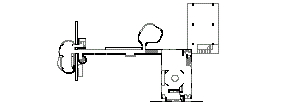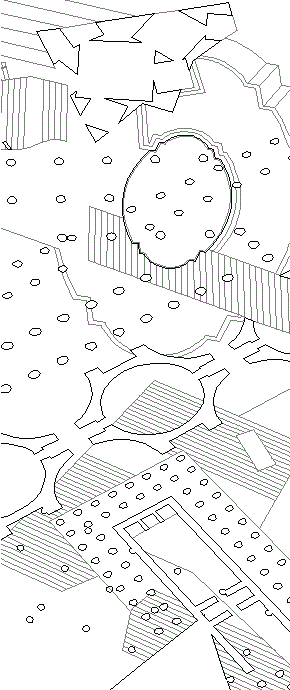1978 Collage City
Interestingly, the words a-temporality and a-temporal make an appearance within the text of Collage City:
"Presented with Marinetti's chronolatry and Picasso's a-temporality; presented with Popper's critique of historicism (which is also Futurism/futurism); presented with the difficulties of both utopia and tradition, with the problems of both violence and atrophy; presented with alleged libertarian impulse and alleged need for the security of order; presented with the sectarian tightness of the architect's ethical corset and with more reasonable visions of catholicity; presented with contraction and expansion; we ask what other resolution of social problems is possible outside the, admitted, limitations of collage. Limitations which should be obvious enough; but limitations which still prescribe and assure an open territory."
The only architectural collage actually in the book Collage City is the frontispiece:

David Griffin and Hans Kolhoff, City of composite presence (1978).
1982 The Architecture of the City
"After I wrote this book and from the concepts I postulated in it, I outlined the hypothesis of the analogous city, in which I attempted to deal with theoretical questions concerning design in architecture. In particular I elaborated a compositional procedure that is based on certain fundamental artifacts in the urban reality around which other artifacts are constituted within the framework of an analogous system. To illustrate this concept I gave the example of Canaletto's fantasy view of Venice, a capriccio in which Palladio's project for the Ponti di Rialto, the Basilica of Vicenza, and the Palazzo Chiericate are set next to each other and described as if the painter were rendering an urban scene he had actually observed. These three Palladian monuments, none of which are actually in Venice (one is a project; the other two are in Vicenza), nevertheless constitute an analogous Venice formed of specific elements associated with the history of both architecture and the city. The geographic transposition of the monuments within the painting constitutes a city that we recognize, even though it is a place of purely architectural reference. This example enables me to demonstrate how a logical-formal operation could be translated into a design method and then into a hypothesis for a theory of architectural design in which the elements were preestablished and formally defined, but where the significance that sprung forth at the end of the operation was the authentic, unforeseen, and original meaning of the work."
Aldo Rossi
| |
1982 Mayor's House 2269
1983 Parc de La Villette
1984 Casa Collage 001 225a
1984 Casa Collage 002 225b
1984 Casa Collage 003 225c
1984 Casa Collage 004 225d
1984 Casa Collage 005 225e
1984.12.01
Neue Staatsgalerie
Finally, there is the theme of stylistic eclecticism. Here there is neither frivolity now regression. The simultaneous references to various vocabularies does not interfere with the unity of the composition. This is because each allusion applies only to isolated elements that do not intervene in the general concept of the work, and because these references become ironical because of the contradictions between vocabulary and technological executions.
It is difficult to find another building that conveys, with such perfection, a linguistic coherence and faithfulness to the syntax of the most radical avante garde of the Modern Movement, and this despite the use of various historical quotations. These quotations--Neo-Classical, Baroque, Corbusian, Constructivist or Loosian--have another important progrommatic value: they demonstrate how electicism can use recent traditions, and thus, how the Modern Movement can be included in the continuum of history.
--Oriol Bohigas
1993 Parthenon columns at Wall House 2 2283
1993 Parthenon columns at Villa Stein de Monzie 2284
1993 Analogous Building 2287
1995.07.24
The Timepiece of Humanity
The present moves in only one direction, a direction wherein the future becomes the past. As the present animates time, it simultaneously transforms an inert future into an inert past. In this sense, the past and the future are the same; one becomes the other, and they both share an inert existence. Time is, therefore, one huge continuum, consisting almost entirely of an inert past and an inert future. The past and future coexist in time, and it is only the present that brings time out of inertia.
1998 virtue2vicegrip machine4living 2299

1999 Ur-Ottopia House 2303
| |
1999 Maison Millennium 001 2304
1999 Palace of Ottopia 2305
1999 Lauf Haus der Kunst 2306
1999 Schizophrenic Folds 2307
1999.02.23 19:08
Re: irrational architecture
You raise an interesting point which suggests a paradigm shift in how we perceive (and I use that term loosely) space-architecture, however, I don't think such an operational shift is all that "simple," nor does the notion of "space moving through us" necessarily eliminate architecture. To your idea, I'd like to add a complementary idea (not entirely mine) regarding the continuum of time.
It is common to perceive time as moving, specifically in a linear fashion--past, present, future. Time, as Einstein suggests, is a continuum, and therefore past and present coexist, and thus, relatively speaking, past and future do not move. It is the present that moves through the continuum of time and, much like a radio, picks up "signals" relative to its position within the continuum band. Within such a continuum paradigm, both we AND space move through time. In terms of endurance of presence, however, much great architecture clearly holds its own in terms of the span of time (and here the Great Pyramids of Egypt getting close to 5000 years old are the prime example). Perhaps what we today are experiencing more than anything in our present "built environment" or "space" is its (almost patented) premature obsolescence.
2000.02.03 15:08
austerity = extreme assimilation?
Perhaps one of the drawbacks of the 'being-there-right-as-it-happens-history' of today's culture is that the sense of continuum is no longer as evident as it was in former times. With everything "new(s)' being automatically understood as 'of this very moment', the sight of 'events' being part of a much larger continuum is easily lost. I have a feeling that a 'style' like Purism(/New Austerity) is going to be part of 'international' architecture (and culture) for a few more centuries. It's already proved itself durable for almost a century, hasn't it?
2000 ichnographia non-virtual non-context

2000 Ludi 002 2329
| |
2002 Palace of Knowledge 2339
2003.09.04 18:08
in the thick of reenactment season
I purposefully walked from the front door of the Philadelphia Museum of Art down the Benjamin Franklin Parkway to the far side of Logan Circle and then back to the Art Museum. I did this to get a real sense of scale of the virtual axis of life within Piranesi's Ichnographia Campus Martius.
In reality I was walking across the forecourt of the Philadelphia Museum of Art, then down the steps that Rocky made famous running up, then across Eakins Oval, where the largest painting in the world once was, then down a tree covered allee along the south side of the Parkway stretching for three long blocks, then around Logan Circle, and then back in the direction I came although this time along the north side of the Parkway.
In virtuality I was walking through the Nympheum Neronis high on the Vatican Hill, through the Porticus Neronis, through the Templum Martis (Temple of Mars), through the Area Martis where the Triumphal Way begins its "march" [this is around where the Rodin Museum is on the Benjamin Franklin Parkway, and, as luck would have it, where the route of many of today's Philadelphia parades begin], then I walked around Hadrian's tomb, and then I walked back.
2003.12.13 16:42
which Acropolis do you prefer?
The Acropolis as used by the ancient Greeks?
The Acropolis as used by the ancient Romans?
The Acropolis when the Parthenon was used as a Christian Church dedicated to Mary?
The Acropolis when the Turks used the Parthenon as a munitions magazine (hence the 17th century explosion that pretty much wrecked the place)?
The Acropolis as mass tourist destination with the Parthenon ruins slowly being further destroyed by air-pollution?
Multiple choice, I'm sure.
2003.12.14 17:42
Re: which Acropolis do you prefer?
The explosion of the Parthenon occurred 26 September 1687. It would be interesting to know how many people on Earth 316 years from now will know the date of the attack on the World Trade Center off the top of their head.
Collective memory is a lot more selective than criticism.
For how long did the 'ideal' design of the Acropolis actually exist? Moreover, do we even fully understand what the Acropolis was really like while it manifest it's most ideal existence. For example, how was it all painted? Did a fair amount of the ideal design actually fade as soon as the colors did?
2004.03.16 10:20
Re: before or after the Viking invasion ?
...excerpt from the cover notes of Prehistoric Architecture in the Eastern United States:
"It is the first overview of prehistoric earth architecture in the Eastern United States, from about 2200 BC to AD 1500, and presents 82 sites which provide examples of how, thousands of years before Columbus, aboriginal architects used earth to shape their environments and landscapes from the Great Lakes to the Gulf of Mexico and from the Atlantic Ocean to the Great Plains."
...the formations of the earth architecture(s) is most times very geometric, often with groupings of stunted pyramidal mounds, and the arrangements sometimes resemble the patterns one associates with crop circles.
2004 Good-Bye House 2345
2004 Mikveh PMP 2346
2004 I. Kahn Collagio 2347
2004. 05.04 10:28
Re: the design of incarceration
It's always interesting and useful to know how things happen, and it's just as interesting and useful to know how things un-happen.
2004.05.18 10:26
REPORTAGE- Rhythm & Gender
I like the list; like chapters, like lessons, like evolutionary stages, like different floors of a building I'd love to design, like a row of restaurants while you're perpetually hungry.
Le Corbusier is very high on my list. Go to Harvard's Loeb Library to see my analysis of his unexecuted Palais des Congrès--they were the only ones to purchase both the slides and drawings published in 1991.
Early Mies still intrigues.
Gropius never really inspired me at all.
What I find historically interesting is a comparison and contrast of Freud's first visit to Rome (gen Italia) and Le Corbusier's first visit to the Acropolis.
I'm not sure the Romans ever built in the Doric order. Composite was indeed their order of choice.
Seutonius relates how a delegtion from India came to Rome during the reign of Augustus. This makes me really wonder why the Mausoleum of Augustus in Rome and the Great Stupa in India are virtually identical in size and design.
Why do you think Piranesi first delineated all the circuses of the first printing of the Ichnographia Campus Martius in a stylized manner, and then (unnoticed for over 200 years) changed all the circuses into copies of the Circus of Maxentius in the second printing of the Ichnographia Campus Martiis? Piranesi sure knew how to paint a quaestio abstrusa!
You know how Eutropia confessed that (her son) Maxentius was a bastard soon after Maxentius died in battle against Constantine? Well, I hear Eutropia recently made another confession as to how Maxentius' real father was Diocletian!
|